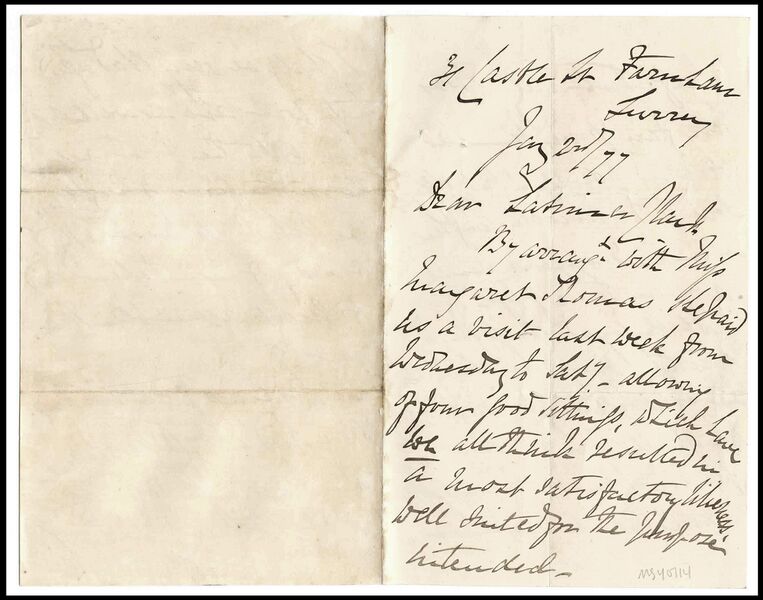File:COOKEletter2JAN1877-RWLipack-Owner-A.jpg

Original file (2,726 × 2,142 pixels, file size: 2.13 MB, MIME type: image/jpeg)
Summary
WM. F. COOKE LETTER DATED 2 JANUARY 1877 TO LATIMER CLARK (OBVERSE): On 2 January 1877 William Fothergill Cooke, now going on seventy years old and two years from his death in 1879 - wrote his old friend Latimer Clark, who was the former master engineer for Wm. F. Cooke's Electric Telegraph Company from the early days.
Latimer Clark later was also instrumental in the formation of I.E.E., or the organization formally known as the Institution of Electrical Engineers. This British society eventually became what is now the modern day I.E.T., or the Institution of Engineering and Technology.
Over the years Clark had as well formed the most comprehensive library collection of books on telegraphy and electricity ever. This collection was purchased for A.I.E.E. (the American Institute of Electrical Engineers) in 1901 by American industrialist Schuyler Skatts Wheeler, and the collection was gifted to the Institute, which became I.E.E.E. Wheeler was the electrical engineer behind designing and successfully marketing the early electric fan in America and made a fortune manufacturing electric fans under the name Crocker & Wheeler Co. out of Ampere, N.J. Wheeler also was an A.I.E.E. past president - The Clark collection came to be held in the Institute's new building built with financial support of steel magnet Andrew Carnegie.
This letter that Wm. F. Cooke wrote to Latimer Clark is significant is that it documents and confirms the name of Cooke's only know portrait painting of himself. The portrait was painted by a very accomplished woman artist named Margaret Thomas.
Margaret Thomas was born on 23 December 1842 and died one day past her 87th birthday on 24 December 1929. She was born at Croydon, Surrey England and was the daughter of Thomas Cook, a prestigious shipowner who founded the great travel agency Thomas Cook and Son. Although English-born, Margaret Cook became an Australian travel writer, poet and artist. She was originally named Margaret Cook later changed her surname to her father's first name.
As a young girl Margaret Cook Thomas was brought to Australia in 1852 by her parents and still in her teens, she came to study sculpture under Charles Summers at Melbourne. She was so prolific that when she was only fifteen years of age in 1857, Margaret Cook Thomas came to exhibit a medallion portrait at the first exhibition held by Australia's Victorian Society of Fine Arts. Around 1867 Thomas ventured to Europe to continue her studies. She had a medallion shown in 1868 at London's Royal Academy exhibition after having studied for three years at Rome where she obtained a studentship at the Royal Academy, London. Then in 1872 Margaret Thomas won the silver medal for sculpture.
At the time Margaret Thomas painted the only known oil portrait of William Fothergill Cooke in 1877, she had been regularly exhibiting mainly portraits at the Royal Academy, beginning in 1868.
It is interesting to note that the Wm. F. Cooke portrait remains unsigned but is by a woman the basically originally had the same last name as William Fothergill Cooke, with out the letter "e." This Wm. F. Cooke was a very humble man, and in the end appears that he chose a very humble artist to capture his most humble likeness in a splendid oil on canvas portrait.
It is this portrait that provides history with a lasting visual record of a man who gave so much to the world with his electric magnetic prowess, besides only one known photograph. It is ironic that as the perfection of the electric telegraph came into being via Cooke's work, Daguerreotype and Calotype photography just came about, and although Cooke clearly had the financial means to afford a photographic likeness of himself, he abstained from doing so - save for only one image: One that is shown at the head of the William Fothergill Cooke I.E.E.E. discussion and posting.
The 1877 Wm. F. Cooke letter reads in part:
"By arrangement with Miss Margaret Thomas, she paid us a visit last week from Wednesday to Sat y (sic) - allowing of four good sittings which have we all think resulted in a most satisfactory likeness well suited for the purpose intended."
Cooke further elaborated:
"I shall be very glad to find that you are as well satisfied with the portrait as the ( ........ ) of the family."
The telegraph inventor closed by saying:
"The lady is assertively a artist of high talents and most agreeable manners."
This 1877 letter by Wm. F. Cooke has been included as an exemplar in the paleography holograph authentication of the 1836-1842 William Fothergill Cooke telegraph builder's journal shown also in part herein illustrated.
File history
Click on a date/time to view the file as it appeared at that time.
| Date/Time | Thumbnail | Dimensions | User | Comment | |
|---|---|---|---|---|---|
| current | 02:51, 14 April 2022 |  | 2,726 × 2,142 (2.13 MB) | Richard Warren Lipack (talk | contribs) | WM. F. COOKE LETTER DATED 2 JANUARY 1877 TO LATIMER CLARK (OBVERSE): On 2 January 1877 William Fothergill Cooke, now going on seventy years old and two years from his death in 1879 - wrote his old friend Latimer Clark, who was the former master engineer for Wm. F. Cooke's Electric Telegraph Company from the early days. Latimer Clark later was instrumental in the 1884 formation of A.I.E.E. formally known as the American Institute for Electrical Engineers. Today A.I.E.E. is known as I.E.E.E.... |
You cannot overwrite this file.
File usage
The following page uses this file: